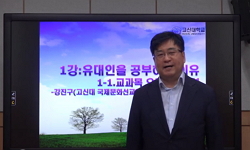The iconoclastic policy of LeoⅢ has not been properly estimated in the Byzantine history because many scholars have generally studied LeoⅢ`s iconoclasm on the basis of the extant documents which included biased views of iconodules. They have conde...
http://chineseinput.net/에서 pinyin(병음)방식으로 중국어를 변환할 수 있습니다.
변환된 중국어를 복사하여 사용하시면 됩니다.
- 中文 을 입력하시려면 zhongwen을 입력하시고 space를누르시면됩니다.
- 北京 을 입력하시려면 beijing을 입력하시고 space를 누르시면 됩니다.
부가정보
다국어 초록 (Multilingual Abstract)
The iconoclastic policy of LeoⅢ has not been properly estimated in the Byzantine history because many scholars have generally studied LeoⅢ`s iconoclasm on the basis of the extant documents which included biased views of iconodules. They have condemned that he took measures of iconoclasm due to Jewish or Muslim influence. This study analysed the distorted Byzantine sources critically and used oriental materials which remained without prejudices of iconodules to fairly examine Leo`s iconoclasm. Chapter two traced Byzantine sources which contain stories related to both Leo and Jews. As a result of that, it was proved that the stories were first made by a writer hating iconoclasm, transmitted to later generations, and transformed into other stories in the course of time. Consequently Byzantine accounts explaining the close relationship between Leo and Jews were not the records of truth but just fictions invented by iconodules. Chapter three critically examined the relation between Leo and Muslims in the basis of the oriental sources which remained purely without censorship of iconophiles. On the contrary to the Byzantine documents, these sources proved that Leo had no influence from Muslims. They instead showed that Leo firmly defended Orthodox against Islams. In short the analysis of these Byzantine and oriental sources does not give much support to modern theories of Jewish or Muslim influence on Leo`s iconoclasm. What did then motivate him to destroy images? Chapter four investigated the motivations of Leo`s iconoclasm. Leo had a political thought that Emperor is the only representative of God in earth because God gave over him an absolute power. This thought of Leo was clearly expressed in the preface of Ecloga, a law-code which had been published just before he took iconoclastic measures. He did not hesitate to decide iconoclasm because he strongly hold the ideology of, so to speak, Caesaropapism. The early period of Leo`s reign was dominated by several critical issues: the pressure of Arabs and Bulgars in frontier districts; the military expansion of Lombards in Italy; and the widespread of image cults in the whole empire. He domestically wanted to gather together the scattered energies of the people by means of iconoclastic device. Based on the concentrated energies, he hoped to revive the glory of Justinian Empire in the past. LeoⅢ`s iconoclasm was the best policy to satisfy such need and hope as he aspired to do.
참고문헌 (Reference)
1 김차규, "레오 3세와 성상파괴 논쟁" 10 : 109-138, 1999
2 Stephen of Traon, "Universal History. 2nd edition" (St. Petersburg 1885
3 C. de Boor, "Theopharis Chronographia recensuit, In Vol. I" Leipzig 1883
4 K.A.C. Creswell, "The lawfulness of pairting in early Islam" XI (XI): 159-166, 1946
5 L.W. Barnard, "The Graeco-Roman and Oriental backgrounf of the Iconodastic controversy" Leiden 1974
6 Leo Donald Davis, "The First Seven Ecumerical Counals, In Their History and Theology" The Liturgical Press 325-787, 1990
7 Emst Kitzinger, "The Cult of Imager in the Age before Iconoclasm" 8 : 83-150, 1954
8 Theophanes, "The Chronide of Theophanes Confessor: Byzattine and Near Eastern History AD 284-813" Clarendon Press 1997
9 George Ostrogorsky, "The Byzartine Empire in the World of the Severth Century" 13 : 1-21, 1959
10 J.D. Marisi, "Sacrorum Condiliorum Nova et Amolissima Collectio" Dlorence XIII : 1767
1 김차규, "레오 3세와 성상파괴 논쟁" 10 : 109-138, 1999
2 Stephen of Traon, "Universal History. 2nd edition" (St. Petersburg 1885
3 C. de Boor, "Theopharis Chronographia recensuit, In Vol. I" Leipzig 1883
4 K.A.C. Creswell, "The lawfulness of pairting in early Islam" XI (XI): 159-166, 1946
5 L.W. Barnard, "The Graeco-Roman and Oriental backgrounf of the Iconodastic controversy" Leiden 1974
6 Leo Donald Davis, "The First Seven Ecumerical Counals, In Their History and Theology" The Liturgical Press 325-787, 1990
7 Emst Kitzinger, "The Cult of Imager in the Age before Iconoclasm" 8 : 83-150, 1954
8 Theophanes, "The Chronide of Theophanes Confessor: Byzattine and Near Eastern History AD 284-813" Clarendon Press 1997
9 George Ostrogorsky, "The Byzartine Empire in the World of the Severth Century" 13 : 1-21, 1959
10 J.D. Marisi, "Sacrorum Condiliorum Nova et Amolissima Collectio" Dlorence XIII : 1767
11 "Patrologia Graeca"
12 T.W. Amold, "Painting in Islam" 1965
13 G.B. Laclner, "Origin and Signficance of the Byzartine Oconoclastic Controversy" Ⅱ : 127-149, 1940
14 John Damascene, "On Holy Images trans" London Thomas Baker 1898
15 S. Gero, "Notes on Byzartine Iconoclasm in the eighth centur" XLIV : 23-42, 1974
16 C. de Boor, "Nicephori Archeniscopi Const antinopolitani Opusoula Historica" Leipzig 1880
17 Raymond Davis, "Liber Ponrificalis (vita Gregorii Ⅱ) in The Liver of the Eighth-Century Popes (Liber Portincalis): The Ancient Biographies of Nine Popes from AD 715 to AD 817" Liverpool University Press 1992
18 Frederic P. Miller, "John McBrewster eds. Iconodasm" Alphascript Publishing 2010
19 P. Crone, "Islam Judeo-Christianity and Byzartine Iconoclasm" Ⅱ : 59-95, 1980
20 G.R.D. King, "Islam Iconoclasm and the Declaration of Doctrine, Bulletin of the School of Oriental and Afican Studies" 48 (48): 267-277, 1985
21 Thomas F.X. Noble, "Images Iconoclasm and the Cardingians" Univ. of Pennsylvaria Press 2009
22 A.A. Vasiliev, "History of the Byzartine Ernpire" University of Wisconsin Press 1958
23 Philip K. Hitti, "History of the Aralos" 1956
24 Kitab al -Unvan, "Histoire universelle ecrite par Agarius de Merbudi. ed. A.A. Vasiliev. 2 Partie" Patrologia Orientalis 8. fasc. 3 1912
25 Andrew Louth, "Greek East and Latin West: the Church AD 681-1971" St Valdimir's Seminary Press 2007
26 C.E. Zacharia von Lingenthal, "Collectio Librarum Juris Graeco-Rornani Ineditorum" Leipzig 1852
27 John Meyendorff, "Byzartine Views of Islam" 18 : 113-132, 1964
28 Stephen Gero, "Byzartine Iconodasm During the Reign of LeoⅢ with Paticular Attention to the Oriental Sources" Secretariat du Corpus SCO Waversebaan 1973
29 Michael Angold, "Byzantiun: The bridge from Anriquity to the Middle Ages" St. Martin's Press 2001
30 G.E. von Grunebaum, "Byzantine Iconoclasm and the Influnence of the Islarnic Environment" 2 (2): 1-10, 1962
31 John of Damascus, "Apologia Agionst Those Decry Holy Imanger Part I. cited in Internet Medieval Source Bool" Halsall 1998
32 A.A. Vasiliev, "'The Iconoclastic Edict of the Caloph Yazid Ⅱ. A.D. 721'" 9/10 : 23-47, 1956
동일학술지(권/호) 다른 논문
-
노사(蘆沙) 문인 최숙민(崔琡民)의 현실인식과 대응양상
- 호남사학회
- 김준형 ( Jun Hyeong Kim )
- 2011
- KCI등재
-
- 호남사학회
- 임종명 ( Chong Myong Im )
- 2011
- KCI등재
-
근대 중국 언론에 나타난 조선(朝鮮) 여성의 형상(形象)
- 호남사학회
- 유연실
- 2011
- KCI등재
-
중화민족(中華民族) 론하(論下)의 국민통합과 갈등 -민족영웅 악비(岳飛)를 중심으로-
- 호남사학회
- 송한용
- 2011
- KCI등재
분석정보
인용정보 인용지수 설명보기
학술지 이력
| 연월일 | 이력구분 | 이력상세 | 등재구분 |
|---|---|---|---|
| 2026 | 평가예정 | 재인증평가 신청대상 (재인증) | |
| 2020-01-01 | 평가 | 등재학술지 유지 (재인증) |  |
| 2017-01-01 | 평가 | 등재학술지 유지 (계속평가) |  |
| 2013-01-01 | 평가 | 등재학술지 유지 (등재유지) |  |
| 2010-01-01 | 평가 | 등재 1차 FAIL (등재유지) |  |
| 2008-01-01 | 평가 | 등재학술지 유지 (등재유지) |  |
| 2006-06-10 | 학술지명변경 | 한글명 : 전남사학 -> 역사학연구 |  |
| 2006-03-21 | 학회명변경 | 한글명 : 전남사학회 -> 호남사학회영문명 : Chonnam Historical Association -> Honam Historical Association |  |
| 2005-01-01 | 평가 | 등재학술지 선정 (등재후보2차) |  |
| 2004-01-01 | 평가 | 등재후보 1차 PASS (등재후보1차) |  |
| 2003-01-01 | 평가 | 등재후보학술지 선정 (신규평가) |  |
학술지 인용정보
| 기준연도 | WOS-KCI 통합IF(2년) | KCIF(2년) | KCIF(3년) |
|---|---|---|---|
| 2016 | 0.68 | 0.68 | 0.68 |
| KCIF(4년) | KCIF(5년) | 중심성지수(3년) | 즉시성지수 |
| 0.63 | 0.6 | 1.183 | 0.18 |




 KISS
KISS






